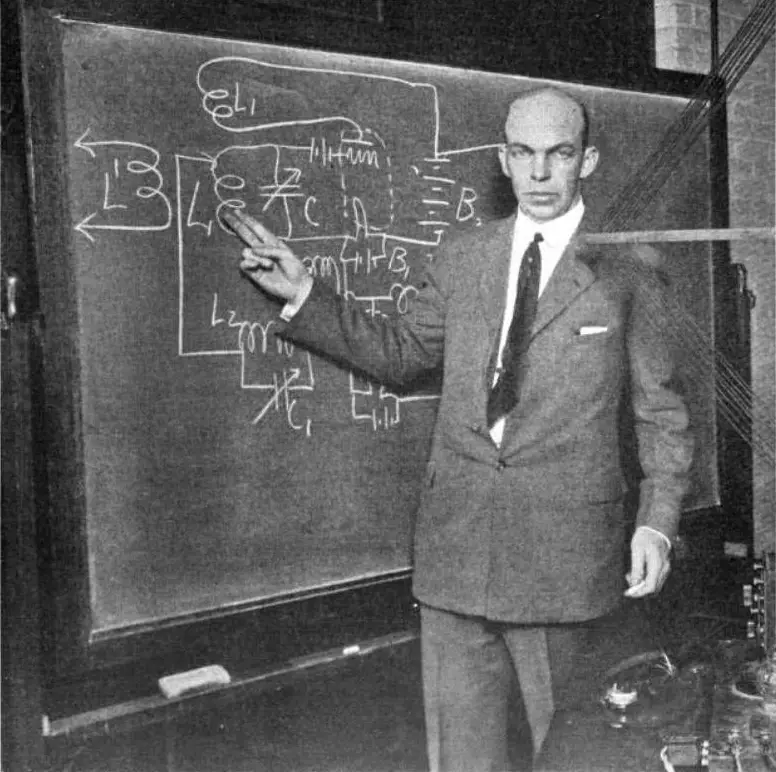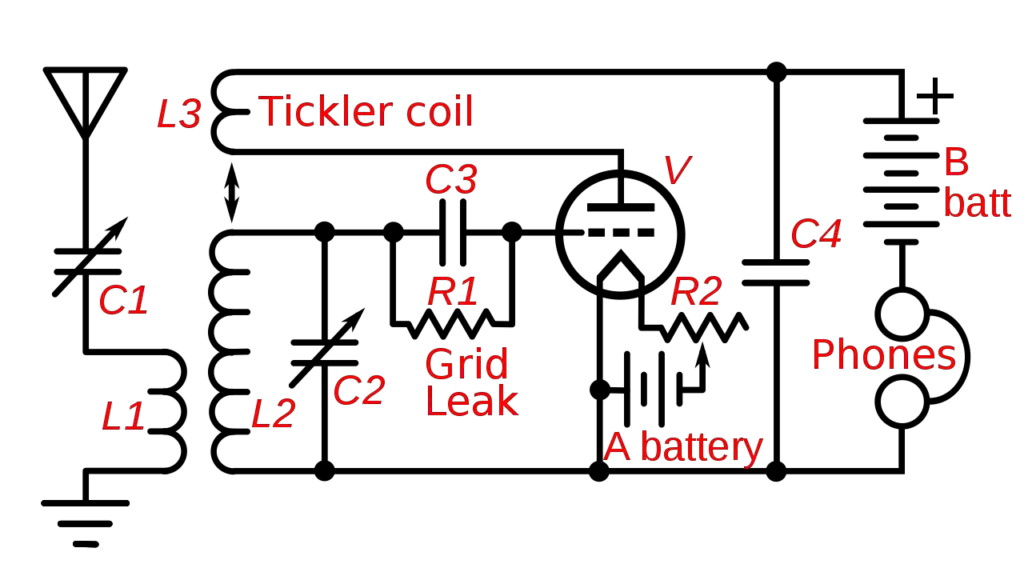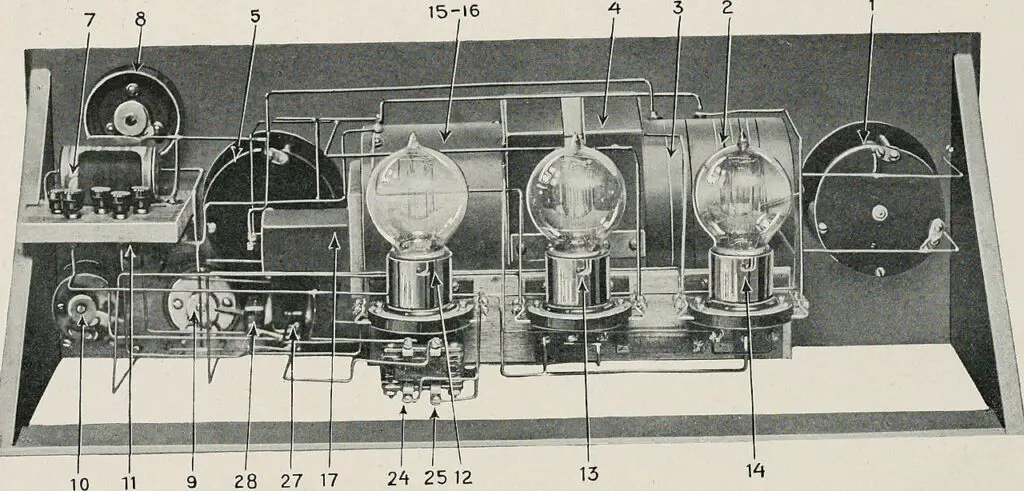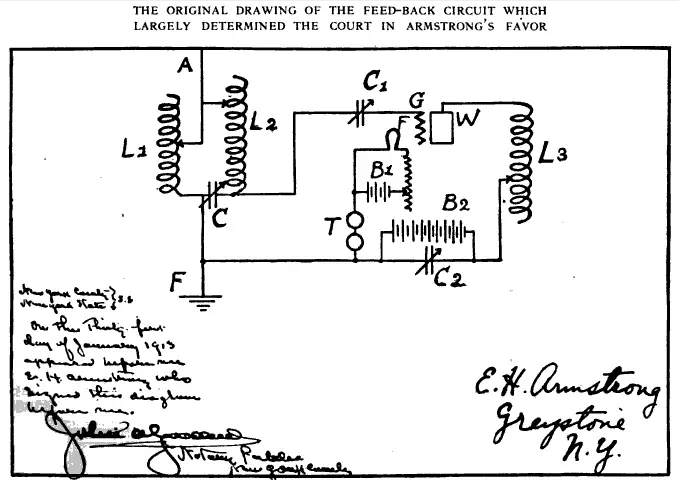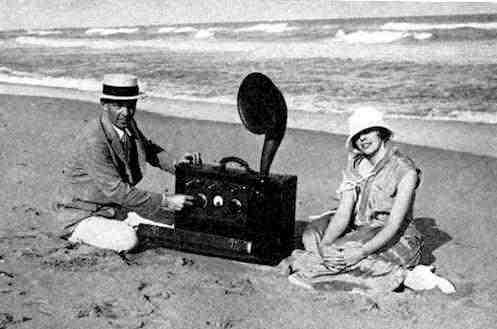Introduction
In the annals of radio history, few names shine as brightly as Edwin Howard Armstrong. A visionary inventor and tenacious innovator, Armstrong’s contributions to the field of radio technology are nothing short of revolutionary. From his early days as a curious student at Columbia University to his groundbreaking inventions that shaped the course of radio’s golden age, Armstrong’s story is one of unparalleled genius, unwavering determination, and tragic battles for recognition. This article delves into the life and legacy of Edwin Howard Armstrong, exploring his pioneering work that laid the foundation for modern radio and his lasting impact on the amateur radio community.
- Introduction
- Early Life and Education
- Birth and early background
- Education and the Genesis of Innovation
- Pioneering Contributions to Radio Technology
- The Invention of the Regenerative Circuit
- Conceptual breakthrough and working principle
- Technical nuances and impact
- The Development of Superheterodyne Receiver
- The necessity for better receivers in a growing radio landscape
- Operational fundamentals and technical sophistication
- The superheterodyne’s pivotal role in radio’s commercial success
- The Creation of Frequency Modulation (FM)
- Limitations of AM radio and the quest for clarity
- The Theory and Math behind FM
- Implementation hurdles and eventual triumph
- The Amplifier That Touched the Clouds: the Superregenerative Receiver
- Working principles and design considerations
- Application in Communication and beyond
- Armstrong’s Impact on Amateur Radio
- The empowerment of amateur radio operators
- Contributions to amateur radio practices and innovations
- The Battles for Patents and Recognition
- The contentious fight with major corporations
- The toll on Armstrong’s personal and professional life
- Legacy and Continuing Influence
- The Armstrong Memorial Research Foundation: Continuing the work
- Armstrong’s inventions in the modern world
- The lasting impression on the amateur and commercial radio communities
- Conclusion
- Further Reading
- Books
- Websites
Early Life and Education
Birth and early background
Edwin Howard Armstrong was born on December 18, 1890, in New York City. From a young age, Armstrong displayed a keen interest in electrical engineering, often tinkering with electrical devices and experimenting with rudimentary radio equipment. This early fascination would prove to be the spark that ignited a lifelong passion for innovation and discovery.
Education and the Genesis of Innovation
Armstrong’s journey into the world of radio began in earnest at Columbia University, where he enrolled in the electrical engineering program in 1909. It was here that Armstrong’s inventive spirit truly flourished. Under the guidance of his mentor, Professor Michael Pupin, Armstrong delved into the intricacies of radio technology, conducting experiments and exploring new concepts that would later form the basis for his groundbreaking inventions.
Pioneering Contributions to Radio Technology
The Invention of the Regenerative Circuit
Conceptual breakthrough and working principle
In 1912, while still an undergraduate at Columbia, Armstrong made his first major breakthrough: the invention of the regenerative circuit. This ingenious design relied on the principle of positive feedback, allowing a radio signal to be amplified to unprecedented levels. By feeding a portion of the output signal back into the input, Armstrong’s circuit effectively “regenerated” the signal, resulting in a significant increase in sensitivity and selectivity.
Technical nuances and impact
The regenerative circuit represented a quantum leap in radio reception capabilities. Prior to Armstrong’s invention, radio signals were often weak and distorted, limiting the range and clarity of transmissions. The regenerative circuit addressed these limitations, enabling radio receivers to detect signals that were previously too faint to be heard. This breakthrough not only improved the quality of radio reception but also expanded the potential reach of radio communications.
Despite the significance of his invention, Armstrong faced challenges in securing recognition and patent rights. He found himself embroiled in legal battles with other inventors and corporations who claimed priority over the regenerative circuit. Nevertheless, Armstrong’s work laid the foundation for the rapid advancement of radio technology in the years that followed.
The Development of Superheterodyne Receiver
The necessity for better receivers in a growing radio landscape
As radio technology progressed and the number of stations increased, the limitations of existing receiver designs became increasingly apparent. The regenerative circuit, while a significant improvement, still struggled with issues of selectivity and sensitivity in the face of a crowded radio spectrum. Armstrong recognized the need for a more sophisticated receiver architecture that could effectively navigate the growing complexities of the radio landscape.
Operational fundamentals and technical sophistication
In response to this challenge, Armstrong developed the superheterodyne receiver in 1918. The superheterodyne design employed a novel approach to signal processing, utilizing the principle of frequency mixing to improve selectivity and sensitivity. By converting the incoming radio signal to a fixed intermediate frequency (IF), the superheterodyne receiver could effectively filter out unwanted signals and amplify the desired signal with greater precision.
The technical sophistication of the superheterodyne receiver was unmatched at the time. Armstrong’s design involved a complex interplay of oscillators, mixers, and amplifiers, each carefully tuned to optimize performance. The mathematics behind the superheterodyne receiver were equally impressive, involving advanced concepts in signal processing and frequency domain analysis.
The superheterodyne’s pivotal role in radio’s commercial success
The introduction of the superheterodyne receiver marked a turning point in the commercial viability of radio. With its superior performance and ability to handle the growing complexity of the radio spectrum, the superheterodyne design quickly became the standard for both consumer and professional radio equipment. The improved reception quality and increased range of superheterodyne receivers helped to fuel the explosive growth of the radio industry in the 1920s and beyond.
Armstrong’s superheterodyne receiver not only revolutionized the technical aspects of radio reception but also played a crucial role in shaping the social and cultural impact of radio. The enhanced clarity and reliability of superheterodyne receivers made radio more accessible and enjoyable for millions of listeners, paving the way for the golden age of radio entertainment and information.
The Creation of Frequency Modulation (FM)
Limitations of AM radio and the quest for clarity
While the superheterodyne receiver had greatly improved the quality of radio reception, it was not without its limitations. Amplitude modulation (AM), the dominant mode of radio transmission at the time, was inherently susceptible to noise and interference. Static, electrical disturbances, and other sources of interference could easily disrupt AM signals, resulting in a degraded listening experience.
Armstrong, ever the visionary, recognized the need for a new approach to radio transmission that could overcome the limitations of AM. He set out on a quest to develop a system that could deliver high-fidelity audio with minimal noise and interference.
The Theory and Math behind FM
Armstrong’s solution came in the form of frequency modulation (FM). Unlike AM, which encodes audio information by varying the amplitude of the radio wave, FM encodes audio by varying the frequency of the carrier wave. This subtle but significant difference held the key to FM’s superior performance.
The mathematical principles behind FM are rooted in the concept of frequency deviation. In FM, the instantaneous frequency of the carrier wave is varied in proportion to the amplitude of the modulating audio signal. The larger the amplitude of the audio signal, the greater the frequency deviation from the center frequency. This relationship is governed by the modulation index, a parameter that determines the extent of frequency deviation.
Armstrong’s FM system employed a wide frequency deviation, allowing for a much higher signal-to-noise ratio compared to AM. By spreading the audio information across a wider frequency range, FM could effectively “outrun” most sources of noise and interference. The result was a remarkably clear and static-free listening experience, even in the presence of adverse conditions.
Implementation hurdles and eventual triumph
Despite the theoretical advantages of FM, Armstrong faced significant challenges in bringing his invention to fruition. The radio industry, heavily invested in AM technology, was initially resistant to the idea of a new modulation scheme. Armstrong’s FM system required new transmitters, receivers, and allocated frequency bands, which represented a substantial investment and departure from the established AM infrastructure.
Undeterred by the skepticism and resistance, Armstrong persevered in his efforts to promote FM. He conducted extensive field tests, demonstrating the superior audio quality and noise rejection capabilities of FM. Slowly but surely, the radio industry began to take notice of the potential of FM.
In 1940, the Federal Communications Commission (FCC) finally allocated a portion of the radio spectrum for FM broadcasting. This decision marked a turning point in the acceptance and adoption of FM technology. As more stations began to embrace FM and manufacturers produced FM-capable receivers, the benefits of Armstrong’s invention became increasingly apparent to both the industry and the listening public.
The FM revolution had begun, and it would forever change the landscape of radio broadcasting. Today, FM remains the dominant mode of radio transmission, offering listeners a level of audio fidelity and clarity that was once thought impossible. Armstrong’s vision and perseverance had triumphed, cementing his place as one of the greatest innovators in the history of radio.
The Amplifier That Touched the Clouds: the Superregenerative Receiver
Working principles and design considerations
In addition to his work on the regenerative circuit, superheterodyne receiver, and FM, Armstrong made another significant contribution to radio technology with the development of the superregenerative receiver. This unique amplifier design, introduced in the early 1920s, pushed the boundaries of signal amplification to new heights.
The superregenerative receiver operates on the principle of exponential amplification. It combines the regenerative feedback concept with a periodic quenching mechanism that allows the amplifier to achieve extremely high gains. The key to the superregenerative receiver’s performance lies in its ability to rapidly switch between a state of high amplification and a state of quenching, or damping, of the oscillations.
The design considerations for the superregenerative receiver were complex and required a deep understanding of radio frequency dynamics. Armstrong’s technical analysis of the circuit involved intricate mathematical modeling of the amplification process, taking into account factors such as the quenching frequency, regeneration time constants, and the nonlinear behavior of the active components.
Application in Communication and beyond
The superregenerative receiver found immediate application in the realm of amateur radio. Its exceptional sensitivity and simplicity made it an attractive choice for radio enthusiasts seeking to push the limits of long-distance communication. Amateur radio operators embraced the superregenerative design, using it to establish contact with distant stations and explore the boundaries of the radio spectrum.
Beyond its impact on amateur radio, the superregenerative receiver also played a role in the early development of television technology. The high-gain characteristics of the superregenerative amplifier made it well-suited for the amplification of the weak video signals in early television systems. Although eventually superseded by more advanced techniques, the superregenerative receiver served as a stepping stone in the evolution of television broadcasting.
Armstrong’s superregenerative receiver stands as a testament to his innovative spirit and his ability to push the boundaries of radio technology. While not as widely known as his other inventions, the superregenerative receiver remains an important milestone in the history of radio and a reflection of Armstrong’s unparalleled contributions to the field.
Armstrong’s Impact on Amateur Radio
The empowerment of amateur radio operators
Edwin Howard Armstrong’s inventions had a profound impact on the amateur radio community. His groundbreaking work in radio technology democratized access to sophisticated communication tools, empowering amateur radio operators to explore the airwaves in ways that were previously unimaginable.
The regenerative circuit, superheterodyne receiver, and superregenerative amplifier, in particular, were eagerly adopted by radio enthusiasts. These innovations provided amateur operators with the means to construct highly sensitive and selective receivers, enabling them to detect weak signals from far-off stations. The accessibility of Armstrong’s designs allowed amateur radio to flourish, fostering a vibrant community of experimenters and innovators.
Contributions to amateur radio practices and innovations
Armstrong’s inventions not only enhanced the capabilities of amateur radio operators but also inspired a wave of further experimentation and innovation within the community. Amateur radio operators, known for their resourcefulness and ingenuity, built upon Armstrong’s work to develop their own modifications and improvements to radio technology.
The superheterodyne receiver, for example, became a mainstay in amateur radio equipment, with operators adapting and refining the design to suit their specific needs. The superregenerative amplifier found applications in amateur television experiments, enabling operators to transmit and receive rudimentary video signals.
Armstrong’s legacy in amateur radio extends beyond his technical contributions. His spirit of curiosity, experimentation, and perseverance resonated deeply with the amateur radio community. Armstrong’s example inspired generations of radio enthusiasts to push the boundaries of what was possible, to explore new frontiers in radio communication, and to share their knowledge and experiences with others.
Today, amateur radio operators continue to build upon the foundation laid by Armstrong. His inventions, now nearly a century old, remain relevant and influential in the modern era of digital communication and software-defined radio. The principles and techniques pioneered by Armstrong are still studied, adapted, and applied by amateur radio operators around the world, a testament to the enduring impact of his work on the hobby and the community.
The Battles for Patents and Recognition
The contentious fight with major corporations
Throughout his career, Edwin Howard Armstrong found himself embroiled in a series of bitter legal battles over the ownership and recognition of his inventions. The most notable of these conflicts involved the Radio Corporation of America (RCA), a powerful entity that held a virtual monopoly over the radio industry in the early 20th century.
Armstrong’s troubles with RCA began in the 1920s, when the company challenged his patents on the regenerative circuit and superheterodyne receiver. RCA, seeking to maintain its dominance in the radio market, argued that Armstrong’s inventions were not truly original and that the company had prior claims to the underlying technologies.
The ensuing legal battles were lengthy, complex, and emotionally charged. Armstrong, a fiercely independent inventor, refused to back down in the face of RCA’s formidable legal and financial resources. He believed strongly in the validity of his patents and the importance of defending his intellectual property rights.
The conflict with RCA was not limited to the regenerative circuit and superheterodyne receiver. When Armstrong introduced his FM system in the 1930s, RCA once again sought to undermine his work. The company, heavily invested in AM technology, initially dismissed FM as a novelty and worked to delay its adoption by the radio industry.
The toll on Armstrong’s personal and professional life
The prolonged legal disputes with RCA and other entities took a heavy toll on Armstrong’s personal and professional life. The financial burden of the legal battles was immense, with Armstrong pouring much of his own wealth into the fight to defend his patents. The stress and uncertainty of the litigation also weighed heavily on his mental and emotional well-being.
Despite the challenges, Armstrong remained resolute in his convictions. He believed that his inventions had the potential to revolutionize the radio industry and improve the lives of countless people around the world. He saw his fight against RCA and others as a matter of principle, a defense of the rights of independent inventors against the power of corporate interests.
Tragically, the strain of the legal battles, combined with personal and financial difficulties, took a devastating toll on Armstrong. In 1954, at the age of 63, he took his own life, leaving behind a legacy of innovation and perseverance in the face of adversity.
The story of Edwin Howard Armstrong’s battles for recognition and control over his inventions serves as a poignant reminder of the challenges faced by independent inventors in a world dominated by powerful corporate interests. It is a testament to Armstrong’s unwavering commitment to his work and his belief in the importance of defending the rights of those who dare to innovate and challenge the status quo.
Legacy and Continuing Influence
The Armstrong Memorial Research Foundation: Continuing the work
In the wake of Edwin Howard Armstrong’s untimely death, efforts were made to preserve and continue his legacy of innovation and discovery. One of the most significant of these efforts was the establishment of the Armstrong Memorial Research Foundation, an organization dedicated to supporting research and education in the field of radio and electronic engineering.
The Foundation, founded in 1955 by Armstrong’s widow, Marion MacInnis Armstrong, seeks to honor the memory and contributions of the late inventor by fostering the next generation of innovators. Through grants, scholarships, and educational programs, the Foundation provides resources and opportunities for students and researchers to pursue groundbreaking work in the spirit of Armstrong’s own pioneering efforts.
The Armstrong Memorial Research Foundation has played a vital role in advancing the state of the art in radio and electronic technology. By supporting cutting-edge research and providing a platform for collaboration and knowledge-sharing, the Foundation has helped to ensure that Armstrong’s legacy continues to inspire and inform the work of engineers and scientists around the world.
Armstrong’s inventions in the modern world
The impact of Edwin Howard Armstrong’s inventions extends far beyond the golden age of radio. His groundbreaking work laid the foundation for many of the wireless communication technologies that we rely on today, from broadcast radio and television to cellular networks and satellite communications.
The superheterodyne receiver, in particular, remains a fundamental building block of modern radio systems. The basic principles of frequency mixing and intermediate frequency amplification, pioneered by Armstrong nearly a century ago, are still employed in a wide range of applications, from consumer electronics to advanced scientific instruments.
Armstrong’s work on FM has also had a lasting impact on the world of audio and multimedia. The superior sound quality and noise rejection capabilities of FM have made it the standard for high-fidelity audio broadcasting, both in traditional radio and in newer digital formats such as DAB (Digital Audio Broadcasting) and HD Radio.
Beyond their direct technical applications, Armstrong’s inventions have also had a profound influence on the way we think about innovation and the role of the individual inventor in shaping the course of technological progress. Armstrong’s story serves as an inspiration to those who seek to push the boundaries of what is possible, to challenge established norms and conventions, and to pursue their vision with passion and perseverance.
The lasting impression on the amateur and commercial radio communities
Edwin Howard Armstrong’s legacy continues to resonate deeply within the amateur and commercial radio communities. For amateur radio operators, Armstrong’s inventions represent the pinnacle of technical achievement and the embodiment of the spirit of experimentation and discovery that lies at the heart of the hobby.
Amateur radio operators around the world still study and apply the principles and techniques pioneered by Armstrong, adapting his designs to suit the needs of the modern era. The regenerative circuit, superheterodyne receiver, and FM modulation remain staples of amateur radio equipment and experimentation, a testament to the enduring relevance and influence of Armstrong’s work.
In the commercial radio industry, Armstrong’s contributions laid the foundation for the growth and success of radio broadcasting as a mass medium. The improved performance and reliability of Armstrong’s inventions, particularly the superheterodyne receiver and FM modulation, helped to transform radio from a novelty into a powerful tool for entertainment, information, and public service.
Today, as the radio industry continues to evolve in the face of new technologies and changing consumer demands, the lessons and legacy of Edwin Howard Armstrong remain as relevant as ever. His commitment to innovation, his willingness to challenge the status quo, and his unwavering belief in the power of radio to connect and inform people around the world continue to inspire and guide the work of radio professionals and enthusiasts alike.
Conclusion
In the tapestry of technological advancement, few figures loom as large as Edwin Howard Armstrong. His unparalleled contributions to the field of radio technology, from the regenerative circuit and superheterodyne receiver to the development of FM, have left an indelible mark on the world of wireless communication.
Armstrong’s genius lay not only in his technical prowess but also in his unwavering commitment to innovation and his relentless pursuit of excellence. He was a visionary who saw beyond the limitations of his time, a pioneer who dared to challenge the established norms and conventions of the radio industry.
Despite the many challenges he faced, from the resistance of entrenched interests to the personal and financial toll of his legal battles, Armstrong never wavered in his dedication to his work. He believed passionately in the power of radio to transform the world, to connect people across vast distances, and to enrich the lives of countless individuals.
Today, as we enjoy the benefits of Armstrong’s inventions in our daily lives, from the crystal-clear sound of FM radio to the ubiquity of wireless communication, we owe a debt of gratitude to this remarkable man. His legacy serves as a reminder of the transformative power of innovation, the importance of perseverance in the face of adversity, and the enduring impact of a life dedicated to the pursuit of knowledge and the betterment of humanity.
In the end, Edwin Howard Armstrong’s story is one of triumph and tragedy, of brilliance and perseverance, of the unending quest for truth and understanding. It is a story that will continue to inspire and inform generations of inventors, engineers, and dreamers, a testament to the enduring power of the human spirit to shape the course of history and to leave a lasting mark on the world.
Further Reading
For those interested in learning more about the life and work of Edwin Howard Armstrong, the following resources offer a wealth of information and insight:
Books
- “Empire of the Air: The Men Who Made Radio” by Tom Lewis – A comprehensive history of the early days of radio, with a particular focus on the contributions of Armstrong and his contemporaries.
- “Man of High Fidelity: Edwin Howard Armstrong” by Lawrence Lessing – A detailed biography of Armstrong, chronicling his life, inventions, and legal battles.
- “The Legacies of Edwin Howard Armstrong” edited by John W. Morrisey – A collection of essays and articles exploring the impact and significance of Armstrong’s work.
Websites
- The Armstrong Memorial Research Foundation: https://www.armstrongfoundation.org/ – The official website of the foundation dedicated to preserving and promoting Armstrong’s legacy.
- The Edwin Howard Armstrong Papers at Columbia University: https://findingaids.library.columbia.edu/ead/nnc-rb/ldpd_4078700 – An extensive archive of Armstrong’s personal and professional papers, including correspondence, research notes, and technical drawings.
- The Radio Hall of Fame: Edwin Howard Armstrong: https://www.radiohalloffame.com/edwin-howard-armstrong – A concise overview of Armstrong’s life and contributions, with links to additional resources.
- The IEEE History Center: Edwin Howard Armstrong: https://ethw.org/Edwin_H._Armstrong – A collection of articles, photographs, and other materials related to Armstrong’s work, maintained by the Institute of Electrical and Electronics Engineers (IEEE).
These resources offer a starting point for those seeking to deepen their understanding of Edwin Howard Armstrong and his lasting impact on the world of radio and wireless communication. By exploring the life and work of this remarkable inventor, we can gain a greater appreciation for the power of innovation, the importance of perseverance, and the enduring legacy of a true pioneer in the history of technology.

